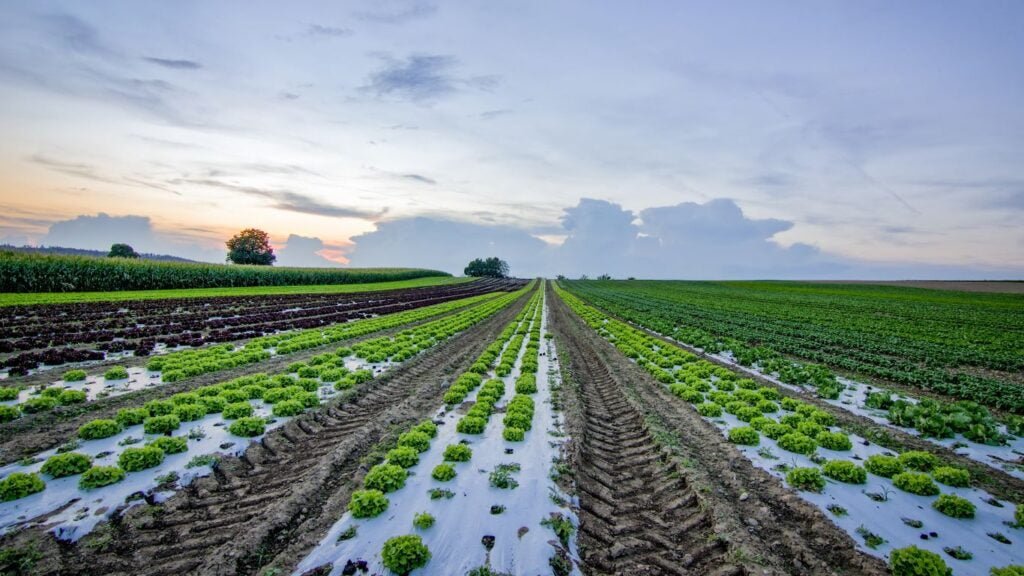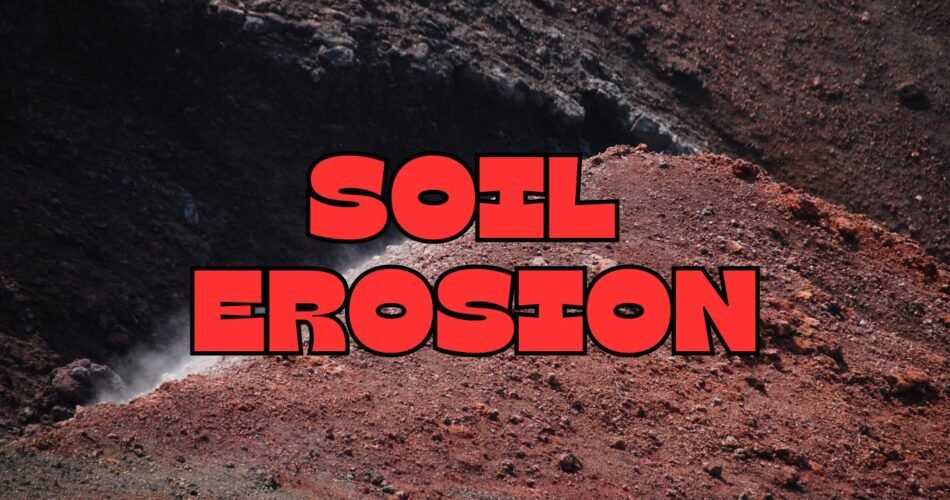This blog contains information about Soil Erosion. In the start, it explains and introduces Soil erosion in detail. Then it describes the Types of Soil Erosion. It also explains the main causes of Soil Erosion. Then it elaborates the Effects of Soil Erosion. In the end, It mentions the Preventive Measures for Soil Erosion in detail. This blog contains Types, Causes, Effects and Preventive Measures of Soil Erosion.
What is Soil Erosion?
Soil Erosion includes all the processes involved in removing the topsoil or the upper layer of soil. This phenomenon is a natural phenomena but it can be triggered by human activities that takes away soil holding objects and properties in different ways.
In this process, the upper layer of the soil is washed away or taken away with some physical sources. Erosion is a natural process that goes continuously but with a very slow speed. But in case of activities in the favor of soil erosion, this procedure can speed up and remove all the important nutrients and fertility of the soil in a very short time period.
Soil erosion includes and triggers land degradation at greater levels. Because it plays significant role in wiping up the nutrients from the soil. This makes soil unsuitable for vegetation and in extreme cases leads to Desertification and Soil Salinity.
Soil erosion keeps going on into the soil even it complete preventive measures are taken. It is because soil erosion may continue with the air and wind, with irrigation water runoffs, Deforestation and many other threats to the soil that can cause soil erosion.
This blog contains every important piece of information about Causes, Effects and Preventive Measures of Soil Erosion. This will help us to know soil erosion with more clarity and detailed form.
Types of Soil Erosion:
Following are the types of Soil Erosion:
Splash Erosion:
This type of erosion is caused by trucking of or splashing of raindrops onto the surface of fertile soil. This erosion displaces soil particles and cause disturbance in topsoil composition.
Sheet Erosion:
This erosion is a continuous process of removal of thin sheets of nutrients from the upper layer of the soil. Sheet erosion of a large area is due to surface runoff and cause great disturbance in soil.
Rill Erosion:
It is the formation of small, narrow channels of water into the soil that flows away the nutrients. This is a fast way of removing nutrients as the flow of water is very much concentrated in the waterways.
Gully Erosion:
Similar to rill erosion, this type of erosion is also because of channels of water in the soil. But these channels are larger and deeper. They cause a large amount of water to flow in them.
Stream bank Erosion:
This is the erosion that exists on the banks of the steams. As water touches the bank of the stream making the soil soften and flows with water along with all the nutrients. It is a faster erosion.
Wind Erosion:
This type of Erosion is by the wind. The flowing wind takes the nutrients away from the soil and this may be very destructive. This erosion continues with time and slowly shows its effects.
These are some basic types of Erosion. This blog contains Causes, Types, Effects and Prevention of Soil Erosion.

Natural Causes of Soil Erosion:
Following are the Natural Causes of Soil Erosion:
Wind:
As we know that air and wind is necessary for life on Earth. Without air living organisms cannot breathe and live on Earth. Wind flows with different speeds and takes away microparticles of the soil with it. It transfers soil properties from one place to another contributing to Soil Erosion. It also plays a great role in wiping of nutrients.
Water runoff:
We irrigate the crops because water is needed for the proper nourishment of the crops. This water runs into the crops and wipe a large amount of nutrients and soil particles from the soil. In the same way when rainwater flows through the field, it takes huge number of nutrients and soil particles with it causing extreme soil erosion. All the nutrients are gone into the drainage systems after heavy rains. Floods are also a great cause of soil erosion.
Gravity:
Wind flow and water flow completely depends on gravity. These physical sources carry out because of the attraction of earth called as gravity. Without this gravitational force, no water drop or wind can act on the soil to cause erosion. We can say that every natural cause of the erosion originates from the force of gravity.
Anthropogenic Causes of Soil Erosion:
Following are the Anthropogenic Causes of Soil Erosion:
Deforestation:
This is the process of cutting down of forests to utilize forest resources for human use. As we know trees holds the Earth and soil nutrients with their deep roots. When these trees are cut, they take most of the nutrients present in the soil with them and leave the soil bare. As the soil is left bare, the process of erosion speeds up and the soil is prone to desertification very soon if no preventive measures are taken.
Agriculture:
As we all know we grow crops and when they are ripen, we harvest them to utilize them as food, for economic purposes and for markets. These crops transfers soil nutrients from the soil into themselves. And when they are harvested, these nutrients are taken away with them. So, slowly the soil become short of nutrients when same crop is cultivated and harvested again and again.
Mining Activities:
Activities related to mining, are a big cause of soil erosion. These activities uses a huge land area and because of chemicals and destruction of land, it cause soil erosion. The degradation of land and inefficient land-use because of mining activities wipes up the nutrients from the soil. These activities cause land pollution and land degradation which leads to soil erosion.
Over-grazing:
The grazing of animals depends upon the people who are managing the herds of animals. If a single piece of land is grazed by animals with their steps or because of eating, the roots of the grasses and plants are destroyed and there is a lot of wastage and removal of nutrients. Over-grazing can be a leading cause of soil erosion because, it removes the nutrients in extreme ways through animals.
Urbanisation:
As the population increase, land-use change also increase in the cities to accommodate the increasing population. The landscape out of the city that is extremely fertile and agricultural in nature, is destroyed for utilizing it for housing societies, new construction projects, economic development and many more reasons. In this process, humans artificially removes nutrients from the land and build concrete roads for the utilization of land.
These are the few causes of Soil Erosion. This blog contains Causes, Types, Effects and Prevention of Soil Erosion.
Effects of Soil Erosion:
Following are the effects of soil erosion:
Desertification:
Extreme soil erosion can lead to the phenomenon of Desertification. It is the process of converting a fertile agricultural land into desert because of unsuitable activities. This problem is increasing every year and turning acres of fertile land into deserts.
Water Pollution:
As we know, surface water runoff is a great cause of soil erosion. This water is filled with nutrients and soil particles. When this water travel through gullies and waterways, they ends up in lakes, canals and rivers. They are filled with nutrients and can cause water pollution in freshwater resources. It can also lead to Eutrophication in case of high concentration of nutrients.
Biodiversity Loss:
Soil erosion removes all the essential nutrients from the soil with passing time. It can be because of harvesting of crops, cutting down of trees and other such activities. It cause extreme habitat loss for the biodiversity living and surviving in that area. This cause migration or death of living organisms.
Compaction:
As the nutrients washes away from the soil, the soil becomes compact. This cause loss in porosity of the soil that reduces infiltration, nutrient absorption and nourishment of the roots in the soil. This makes soil useless for cultivation and cause it to become a desert with passing time.
Climate Change:
Soil erosion does not supports biodiversity such as trees, vegetation, and other things in the favor of climate change. In this way the land contributes in increasing the extreme effects of climate change on earth and does not play a part in mitigation of Climate Change. It also contributes in Global Warming.
These are few major effects of Climate Change.
Preventive Measures for Soil Erosion:
Following are the preventive measures for soil erosion:
Afforestation and Reforestation:
Planting forests will always help to fight with any of the environmental issue. We can apply Reforestation to any abundant forests and utilize its nutrients again before it is too late. We can also apply Afforestation to suitable fertile land that was never a forest, to avoid soil erosion.
Protect Nutrient rich Soil:
Nutrient rich soil works as a glue for earth’s natural resources and Plant Nutrition present in the earth. We should carefully manage and conserve the fertile and organic land in order to avoid environmental problems. We should carry out Restoration practices and Efficient Agricultural process in order to save the land.
Proper Drainage:
Most of the erosion is caused by standing water or unsuitable and poor drainage systems. We should organize proper drainage systems for the agricultural water and there should be no disturbance in drainage systems. The drainage systems should be monitored throughout the time.
Vegetation:
We should not leave the fertile soil bare for soil erosion. This soil should be utilized for vegetation in order to protect the nutrients from certain land area. This vegetation will increase water holding capacity of the land, conserve the nutrients and avoid soil erosion in effective ways.
Retaining Walls:
Another effective way to protect soil from wind erosion and water runoff erosion is to build retaining walls for stopping the flow of erosion through different natural and anthropogenic causes. These walls are effective against the erosion phenomenon as they break the flow of wind and water and avoid damage.
Cover the Vegetation:
If we will cover the vegetation or crops with some insulated material such as mulch, plastic sheets, and other useful covering material, it will help in fighting with wind erosion at a great level. We should apply this technique in the areas where wind is with high speed.
These are the preventive measures for soil erosion.

To learn about more topics, Click the links below:


Comments